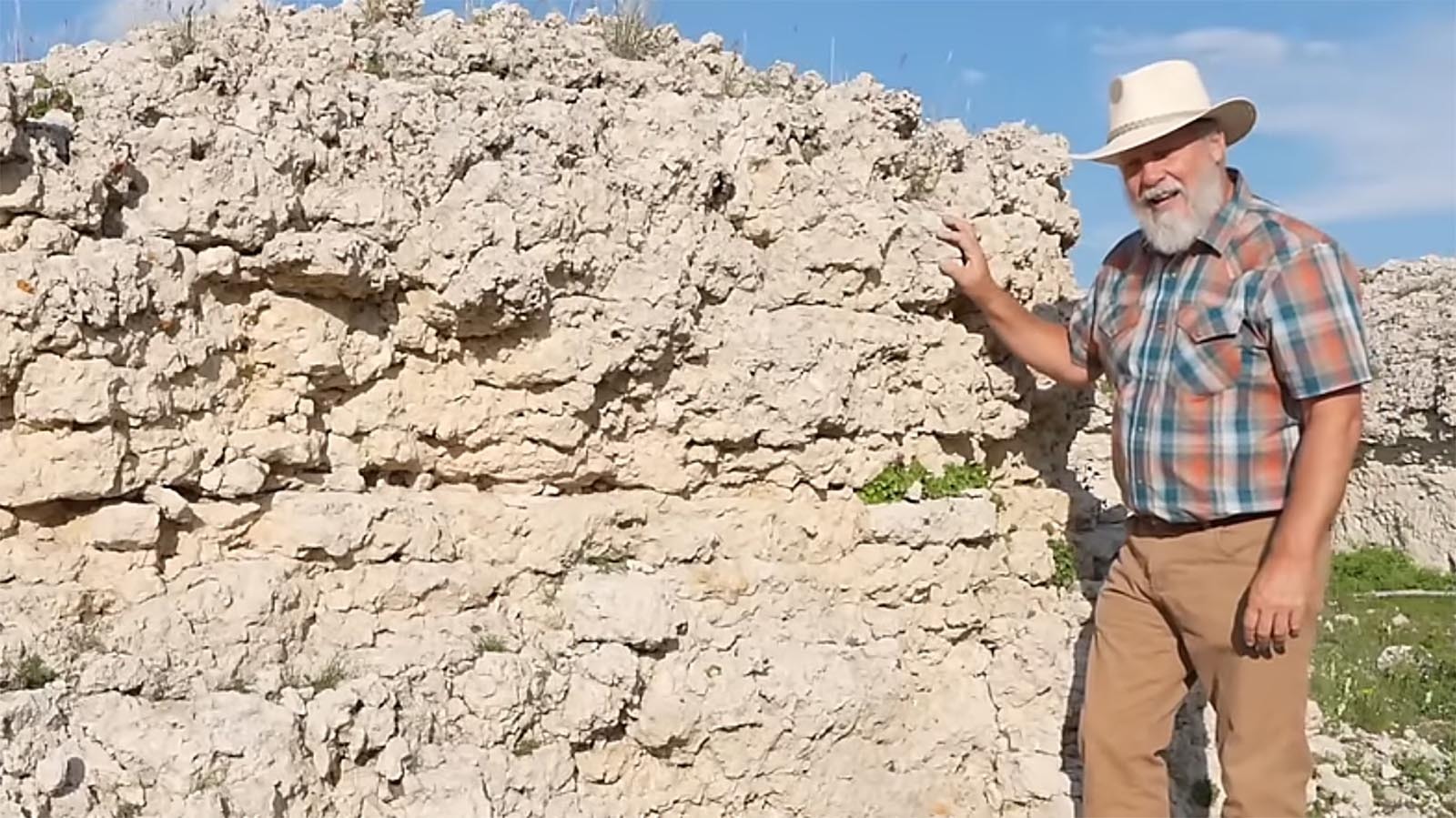Wyoming
Wyoming Geologist Gets Millions Of Views As YouTube Rock Star

Myron Cook wants to show the world the wonders of Wyoming’s geologic features. His YouTube page is allowing him that opportunity, getting millions of views from his nearly 140,000 subscribers and making him a literal rock star on the platform.
“It’s actually turned into a thing,” he said. “I did it just for the joy of geology and communicating geology and it just kind of took off.”
A former petroleum geologist, Cook wanted to share his love for the science with the world after retiring. His 35 years of professional experience and genuine personal interest gives him a high level understanding of how the geological features of Wyoming and the world came to be.
Cook, who now lives in the small northwestern Wyoming town of Burlington, spent the last few years of his career working in Saudi Arabia when the COVID-19 pandemic hit. Due to the rampant lockdowns there, he spent much of his free time watching YouTube videos on photography.
He quickly discovered there was very little geology on the platform, which surprised him. Much of what existed were one-off videos.
After retiring and returning to Wyoming about six months later, Cook took up making YouTube videos to showcase the amazing natural rock features that make up the state and region.
“It almost seems everything was set up perfect for me to do it right at the right time,” he said.
He considers Wyoming as having some of the most interesting geology in the world because it’s easily accessible with the naked eye. Even though geology is everywhere, in order to see the most geologic action, an arid desert landscape is usually required, Cook said.
“Wyoming, especially in the Big Horn Basin area, has just a super high diversity of geology,” he said.
Viral Success
Cook quickly gained a following on YouTube for filling a niche not occupied by many other videographers. Now Cook estimates he gets about 20,000 views per day.
His presentation is rather sophisticated, using multiple cameras and drones to showcase his topics in a visually inviting way to his audience.
“I do everything on my own, every last bit of it,” he said. “The technology to be able to do that … all has come together to not only give people the opportunity to learn, but people like me to produce something.”
Even though his topics could be seen as dry if presented the wrong way, Cook leaps over that hurdle by physically going out to the geologic formations he is discussing, walking and touching the feature.
He expresses genuine enthusiasm while showing off the natural wonders of the world, easily recognizable by his white bushy beard and yellow sun hat.
He also highlights features from different locations to bridge a connection over a single concept.
For instance, in a video released in June, Cook visits a mysterious rock wall in the Badlands. In the same video, he shows how some of the rock formations around the North Fork and Clarks Fork, two visually distinctly different areas outside Yellowstone National Park, were created in the same manner.
He also spends a 90-minute episode explaining the creation of Heart Mountain outside Cody, which came about as a result of an incredible super volcanic explosion and one of the world’s largest landslides, causing the mountain to travel through the air at more than 150 mph until landing in its current space.
Many of the places Cook documents are little known. Sometimes he branches out from Wyoming and the West, doing videos on the geology of Hawaii and the Appalachian Mountains.
His most popular video, which got about 4 million views, showcased a massive salt glacier in the Gulf of Mexico. Cook said less than 1,000 people likely knew about this glacier until his video was released.
“That one I felt really confident about because people like geology in their backyard,” Cook said.
Another extremely popular one was an episode on giant petrified trees outside Worland. In this video, Cook walks the viewer through all the signs that show how the dusty hillside the petrified trees now lay on used to be a muddy creek that eventually ensconced the fallen timber.
Although he does make money off the videos, Cook said he doesn’t want it to feel like a job, so he only makes about one video a month.
What’s It For?
Cook said it’s his primary goal to get people interested in geology to think and see the world around them differently, which he considers the greatest compliment he could receive. The comments he’s received on his videos, he finds extremely gratifying, with some saying the episodes have changed their lives.
“I’ve had people reach and out say, ‘I was extremely depressed, struggling in life, gone through divorce, whatever it might be, and you’ve inspired me to get out, hike and see some geology, enroll in school,’” Cook related. “It’s been extremely gratifying.”
Although his biggest audience is older adults, he still gets a wide variety of views. One person commenting online who identified herself as a 13-year-old girl from Chicago remarked on how much she loves Cook’s videos.
“I don’t understand why most people in my generation have such little interest in the natural sciences,” she said. “I love all of them, geology in particular. It makes me feel like something as every day as a rock has its own unique story behind it, and that story can be brought out through careful investigation and curiosity.”
The fact that both geologists and regular members of the public follow his videos, he also believes is important.
“I feel like I’ve kind of found that right space where it’s good for everybody,” Cook said.
Contact Leo Wolfson at leo@cowboystatedaily.com
Leo Wolfson can be reached at leo@cowboystatedaily.com.

Wyoming
Wyoming Legislature to Convene 2025 General Session Tuesday

The 68th Wyoming Legislature will convene for the 2025 General Session on Tuesday at Noon. The bodies will hold opening ceremonies as their first order of business, and newly elected members of the Legislature and legislative leadership will be sworn in. Following a brief recess, the bodies will begin introduction and referral of bills Tuesday afternoon. All floor proceedings and committee meetings during the 2025 General Session will be broadcast live via the Legislature’s YouTube channel.
The Legislature will then convene in a joint session of the Wyoming Senate and House of Representatives on Wednesday at 10 am, during the second day of legislative proceedings. At that time, Gov. Mark Gordon will deliver his State of the State message, followed by the State of the Judiciary message, delivered by Wyoming Supreme Court Chief Justice Kate M. Fox in the House Chamber at the Wyoming State Capitol.
Wyoming
230 Million-Year-Old Fossil From Wyoming Challenges Dinosaur Origin Theories

Though paleontologists have been discussing the origin and spread of dinosaurs for decades, the widely accepted theory was that they emerged in the southern part of the ancient continent of Pangea over 200 million years ago, and only spread northward millions of years later. A new study dramatically changes the conversation.
University of Wisconsin–Madison (UW–Madison) paleontologists announced the discovery of a new dinosaur that challenges the conventional theory about the dinosaurs’ origin and spread. The location and age of the newly-described fossils suggest that dinosaurs prowled the northern regions of Pangea millions of years earlier than previously hypothesized. The findings were detailed in a January 8 study published in the Zoological Journal of the Linnean Society.
“We’re kind of filling in some of this story, and we’re showing that the ideas that we’ve held for so long — ideas that were supported by the fragmented evidence that we had — weren’t quite right,” Dave Lovelace of the University of Wisconsin Geology Museum, who co-led the study, said in a UW–Madison statement. “We now have this piece of evidence that shows dinosaurs were here in the northern hemisphere much earlier than we thought.”
The paleontologists uncovered the theory-defying fossils in present-day Wyoming in 2013. Due to Earth’s shifting tectonic plates, this region was located near the equator over 200 million years ago on Laurasia, the northern half of Pangea (the southern half was called Gondwana). While the remains were fragmented, the paleontologists were able to attribute the fossils to a new dinosaur species they named Ahvaytum bahndooiveche, which was likely an early sauropod relative. Ahvaytum, however, looked very different from the iconic long-necked herbivores.
“It was basically the size of a chicken but with a really long tail,” said Lovelace. “We think of dinosaurs as these giant behemoths, but they didn’t start out that way.” The adult specimen was just over a foot tall (30.5 centimeters) and about three feet long (91.4 cm).
Perhaps most shockingly, however, is the age of the fossil. Lovelace and his colleagues used radioisotopic dating (a method for determining the age of materials by measuring radioactive decay) to determine that the rock layers where they’d found the Ahvaytum fossils—and thus roughly the remains themselves—were about 230 million years old. This makes Ahvaytum the oldest known Laurasian dinosaur, and about equivalent in age to the earliest known Gondwanan dinosaurs, according to the study. Dinosaurs first emerged during the Triassic period, around 230 million years ago. This era, which lasted from about 252 to 201 million years ago, saw the rise of the earliest dinos, before they became dominant in the Jurassic period.
“We have, with these fossils, the oldest equatorial dinosaur in the world — it’s also North America’s oldest dinosaur,” Lovelace added. The fact that the oldest known Laurasian dinosaur is about as old as the earliest known Gondwanan dinosaurs consequently challenges the theory that dinosaurs originated in the south of the ancient continent and only spread north millions of years later.
The site of the discovery is within the ancestral lands of the Eastern Shoshone Tribe. As a result, the researchers partnered with tribal members throughout their work, and included Eastern Shoshone elders and middle school students in choosing the new dinosaur’s name. Ahvaytum bahndooiveche roughly translates to “long ago dinosaur” in the Eastern Shoshone language.
The region also yielded additional finds. The team identified an early dinosaur-like footprint in older rock layers, meaning that dinosaurs or dinosaur-related creatures were calling Laurasia home even before Ahvaytum. The paleontologists also uncovered the fossil of a newly described amphibian, which was also named in the Eastern Shoshone language.
In challenging long-standing theories about how dinosaurs spread across Pangea, the discovery of the chicken-sized Ahvaytum ultimately paints a clearer picture of the creatures that walked the Earth—and where—millions of years before us.
Wyoming
Lobos come alive in second half to put away Wyoming
-

 Business1 week ago
Business1 week agoThese are the top 7 issues facing the struggling restaurant industry in 2025
-

 Culture1 week ago
Culture1 week agoThe 25 worst losses in college football history, including Baylor’s 2024 entry at Colorado
-

 Sports1 week ago
Sports1 week agoThe top out-of-contract players available as free transfers: Kimmich, De Bruyne, Van Dijk…
-

 Politics6 days ago
Politics6 days agoNew Orleans attacker had 'remote detonator' for explosives in French Quarter, Biden says
-

 Politics6 days ago
Politics6 days agoCarter's judicial picks reshaped the federal bench across the country
-

 Politics4 days ago
Politics4 days agoWho Are the Recipients of the Presidential Medal of Freedom?
-

 Health3 days ago
Health3 days agoOzempic ‘microdosing’ is the new weight-loss trend: Should you try it?
-

 World1 week ago
World1 week agoIvory Coast says French troops to leave country after decades
















